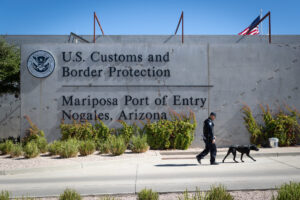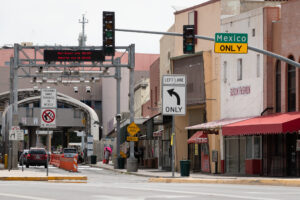- Slug: News–Mexico Tariffs. 1470 words.
- 3 photos available.
By Matthew DeWees
Cronkite News
WASHINGTON – The tariffs President Donald Trump has threatened to impose on imports from Mexico and Canada would drive up the price of gas, groceries and homes in Arizona, economists say – and could blow a hole in state and local budgets that rely heavily on tourism.
“It’s just going to be a self-imposed tax that’s going to increase prices and increase the cost of living in the United States,” said Daniel Scheitrum, assistant professor in the Agribusiness Department at California Polytechnic State University.
Trump announced a 25% tariff on nearly all imports from Mexico and Canada – the nation’s top trading partners, and also Arizona’s – on Feb. 1, with a 10% tariff on Canadian oil, gas and electricity. He immediately put the tariffs on hold until March 4, using the threat as leverage to win concessions on border security.
Both have threatened retaliatory tariffs. So Arizona consumers would face higher prices on imports even as demand for Arizona’s exports drops. The Peterson Institute for International Economics estimates that Trump’s tariffs would cost the average U.S. household $1,200 per year.
Mexico is the biggest customer for Arizona exports – $8 billion worth in 2023, according to census data. Mexico buys copper, electronics, aircraft, engines and parts from Arizona and sells tomatoes, electronic components for autos, peppers, grapes and other produce.
Canada, the state’s second biggest trading partner, sells electricity and wood to Arizona and buys aircraft parts and electronics, among other things.
A look at some of the likely impacts in Arizona if Trump’s tariffs take effect:
Tomatoes and other fresh produce
Imports account for 60% of the U.S. fresh fruit supply and 38% of fresh vegetables, according to the USDA.
“If you want a strawberry in February, you are going to have to grow it somewhere warmer,” said Allison Moore, executive vice president of the Fresh Produce Association of the Americas, based in Nogales.
Mexico supplies just over half of the imported fruit and 69% of the imported vegetables, the USDA says.
Much of that comes into the U.S. through Nogales: about 6.8 billion pounds of produce worth $3.9 billion, second only to the 8 billion pounds imported through the South Texas city of Pharr, according to the association.
The fresh produce import industry is tied to 2,500 jobs and $303 million in annual economic impact in the Nogales area, according to the Santa Cruz Center.
“What we do is important for Arizona,” Moore said, “But what we do is also important for the rest of the country.”
By volume, 10 fruits and vegetables accounted for 89% of the produce imported through Nogales, according to the produce association: tomatoes, watermelons, cucumbers and squash.
Importers will be forced to raise prices if the tariffs take effect, Moore said.
“People are working at margins that are so low that absorbing that kind of added cost will be impossible,” she said. “It’s going to have to be passed along.”
But while fresh produce prices may spike at the grocery store, prices for tree nuts and products made from corn could actually dip, according to Scheitrum, the Cal Poly professor, because those are products that Mexico imports.
If a trade war erupts, the tariffs Mexico imposes would drive up prices for Mexican consumers. A drop in demand south of the border could translate into lower prices in Arizona. But that wouldn’t be enough to offset the impact of a trade war.
“On the whole, your prices will go up because of tariffs,” Scheitrum said.
Imported beer and liquor
Economists say imported beer and liquor would cost more.
“Take the amount of the tariff and tack it onto the top of the price,” said Price Fishback, an economics professor at the University of Arizona. “Most of it is going to hit the consumer.”
That includes Modelo, which became the best selling beer in the United States in 2023.
Constellation Brands sells Modelo, Corona and Pacifico in the U.S. The Rochester, N.Y.-based company bought the U.S. rights to those brands along with a brewery in Nava, Mexico – the world’s largest – in a $4.75 billion deal in 2013. (Grupo Modelo, owned by Anheuser-Busch InBev, makes and sells these beers outside the U.S.)
Ben Hancock, national account manager for Constellation Brands, said the company is taking measures to stave off price hikes as long as possible – stockpiling beer in the U.S. so it can be sold tariff-free and looking at ways to cut costs.
“If the tariffs hit, we’re going to try and keep those cost increases away from our customers and distributors,” Hancock said. “It’s a very fluid situation.”
Gas prices
Gasoline rose 29 cents per gallon in Arizona in the month after Trump took office, according to data from AAA. The average price at the pump is up 5 cents compared to a year ago.
Arizona gets most of its petroleum products by pipeline from California and Texas, according to Tom Pyle, president of the American Energy Alliance, a conservative advocacy group.
Tariffs might not push fuel prices up immediately but the longer they’re in place, the more likely that becomes, he said.
“Arizona is less affected by a tariff on Canadian crude oil because they got most of the fuel gasoline from West Coast refineries … and the Gulf coast,” he said.
But prices eventually equalize, he added, so price hikes in the Midwest and other parts of the country that rely on Canadian crude would spread. And higher energy prices mean higher costs for factories and all sorts of employers.
“Energy … should not be subjected to tariffs,” Pyle said. “It would raise prices across the board.”
Rents and home prices
Single home and apartment construction boomed in 2023 across the country.
In Maricopa County, 35,269 new homes were completed – the most in a decade – according to the Maricopa Association of Governments. Of those, 13,561 were apartment units, the most since at least 2000.
Steel prices spiked in fall 2021 during the global supply chain crisis triggered by the COVID-19 pandemic. They’ve dropped by more than half since then, according to Trading Economics, a firm that tracks global commodity prices.
One of Trump’s stated goals is to encourage more domestic steel production. But that would take time, and builders aren’t sure what tariffs would mean for them.
“It takes years and years and years and hundreds of millions if not billions of dollars to build these factories,” said Josh Tracy, senior vice president of real estate development at Ryan Companies, a major developer in Arizona.
In the meantime, he said he expects steel producers – rather than their customers – to absorb much of the cost of tariffs.
“Because market demand is softer, we don’t expect it to be a dollar-for-dollar pass-through,” Tracy said. “It’s a moving target, and it’s uncertain.”
Jonas Gamso, associate professor at ASU’s Thunderbird School of Global Management, pointed to Trump’s deportation effort as another factor looming over the construction sector. Many economists expect labor shortages for homebuilders and other employers.
“We have a robust housing market that people are increasingly finding themselves priced out of,” Gamso said – and the combination of Trump policies would make that worse. “These things can compound.”
Tourism and tax revenue
Tourism in the Grand Canyon State generated $2.6 billion in state and local tax revenue in 2023, according to the Arizona Office of Tourism.
The $1.15 billion that went into state coffers accounted for 10% of the state’s annual budget. And tourism accounted for 187,000 jobs in Arizona, according to the tourism office.
Roughly 3.3 million of the out-of-state visitors to Arizona – one in 10 – came from Mexico, according to the tourism office.
As part of his pushback against Trump, Canadian Prime Minister Justin Trudeau urged Canadians to spend their vacation dollars at home rather than in the United States. Resentment in Mexico is also brewing, and tourism and revenue officials worry that backlash will keep visitors away.
“Now is the time to choose Canada,” Trudeau said in a nationally televised speech Feb. 1, announcing his country’s response to Trump’s tariff threat. “It might mean changing your summer vacation plans to stay here in Canada and explore the many national and provincial parks, historical sites and tourist destinations our great country has to offer.”
Canada accounts for more than 20 million annual visits to the U.S., according to the U.S. Travel Association, an industry group.
“These tariffs that Trump is threatening to impose on Canada and Mexico will only hurt our hard-working Americans,” said Sarah Benatar, Coconino County treasurer, on a recent webinar with several state treasurers who also oppose the tariffs.
Coconino includes Flagstaff, Page and parts of Sedona and the Grand Canyon and relies heavily on tourism.
Benatar said the possibility of tariffs and their impact is unsettling as officials plan for flood and fire season.
“Just the threat alone and that uncertainty is really causing chaos … across the state,” she said.
Dave Young, Colorado state treasurer, echoed the point, warning that lower revenue will force cuts in essential services.
“The president is playing chess,” he said. “But these are real people’s lives.”
For more stories from Cronkite News, visit cronkitenews.azpbs.org.


